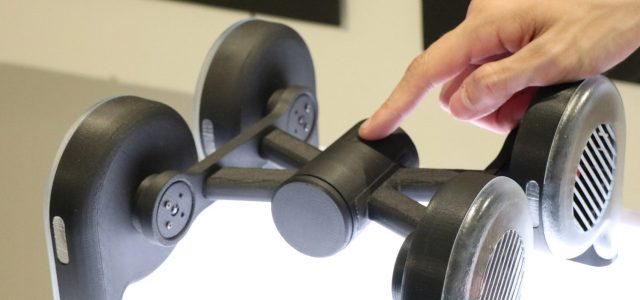Royal College of Art graduate Marcus Kung has designed a drone that can fly without propellers, with the aim of reducing injuries. The Impeller Drone — Kung’s graduate project as part of the RCA‘s masters program in Design Products — flies using four air blowers, instead of exposed rotor blades like most drones. He created the product in an effort to make drones safer for casual users and bystanders.
“Drones are popular but they’re dangerous,” says Kung. “The most common drone accident is people getting cut and hurt by the drones exposed rotor blades. A kid got his eyeball cut open by them.”
“So I started questioning whether there’s anything that in the future could replace rotor blades,” Kung continued. “I looked into different kinds of technologies and eventually I found this system, the blower impeller. I redesigned it, put it on the drone and started vertical takeoff tests.”
The impeller system sucks air in through the vents on the side of the drone and then accelerates it through a circular duct, creating an upward thrust as the air is pushed out through the bottom.
For now, the motor efficiency does not compare well with a standard drone, but Kung hopes that can be improved with more development.




















The idea and the design is laudable and brilliant from the safety standpoint. However, impeller or even ‘squirrel-cage’ type blowers are far less efficient than rotor blades. The efficiency as well as the safety factor can be increased by enclosing the rotors in a ‘ducted fan’ configuration. This can be done with rotors as small as 1in in diameter all the way up to 6-8in rotors.
I believe he is on the right track. The use of a more efficient impeller may be useful. Possibly the use of the “Lily” impeller. In that scenario it may be possible to use less, possibly one impeller, that forces the air in columns that have internal airways containing vanes controlling internal turbulence and possibly increasing airflow through pathway. Which possibly may decrease energy used in pressure production at the exit of flow. And which may allow for a decrease of internal resistance and pressure from entrance to exit allowing more pressure at exit.
The internal vanes and the narrowing passageway may negate each of their individual increase of value to a percentage. Yet without the use of either or both I would expect to see a loss greater than using both at the same time.
The “Lily” impeller (*or possibly a different design could possibly be situated such as in its own tube of sorts to prevent wind while stationary or in flight, to have less effect on air flow compared to a propeller wether encclosed or not.
Also their may be a way to increase the flow into the “Lily” such as specific places and certain orifice size parralel to its center or shaft.
If this unknown would work there would obviously be an increase of pressure at the exit. I believe that quite possibly this may increase energy consumption yet remain within useful parameters.
The vanes of the “Lily” may need to collapse (get smaller) or retain its distance in its relationship from the shaft to some percent over its length to be able to consume the air from ports introducing more air within its length and or width.
There may be indication for the pattern of entrance holes to be all perpendicular to the same point on center of shaft. Yet different patterns of entrance hole may be more appropriate for best result. Such as following the same direction of spiral experimenting with different angles of descent either continuous or varying. And the same experiment reverse of the set “Lily” spiral.
Not knowing and assuming the ports would be advantages in either or both increasing end result pressure or allowing impeller to spin with less resistance, there may need be adjustable ‘doorways’ to control airflow.
The use would be
1-to allow removal of to much pressure affecting possibly slowing impeller.
2-allow for increase of pressure when impeller has reserved ability.
These could be controlled I believe by doors of proper *size and *shape using oil bearing resistance.
Some if not all of these suggestions have variables of advantage according to the size and material used to construct model.